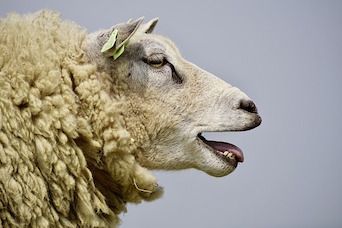Artificial Intelligence Recognizes and Assesses Pain Levels in Sheep
A research team from the University of Cambridge has developed an automated system that uses facial recognition to detect and assess pain in sheep.

A research team from the University of Cambridge has developed an automated system that uses facial recognition to detect and assess pain in sheep. Study results were presented at the 2017 IEEE International Conference on Automatic Face and Gesture Recognition.
Sheep can suffer from painful diseases like foot rot and mastitis. Detecting and assessing this pain is crucial to sheep welfare, allowing for early diagnosis, proper treatment, and pain reduction.
In a press release, Sarah Collins, a spokeswoman from the University of Cambridge, said that, "From a farmer's point of view, a sheep that is in pain due to foot rot or [another] condition is also one that won't put on weight, so it's in both the farmer's financial and moral interests to ensure that their sheep are cared for."
Animals commonly indicate pain through various facial expressions. To date, though, analysis of sheep facial expressions remains a relatively unexplored research area.
The Sheep Pain Facial Expression Scale (SPFES) was recently developed to manually recognize and measure pain in sheep. This scale uses 5 facial indicators—cheeks tightened, eyes narrowed, ears folded forward, lips pulled down and back, nostril shape change from a ‘U’ to a “V”—to score pain from 1 to 10. A previous study reported the scale’s high accuracy in assessing pain in sheep.
Despite this high accuracy, manual scoring methods are not preferable because they are time-consuming and can introduce individual bias into the scoring process.
For the current study, researchers used the SPFES as a basis for an automated facial recognition system to assess pain levels in sheep. Two datasets with a total of 480 images containing frontal views of sheep faces were used. Each image was labeled with 5 features:
- Nose
- Left ear
- Right ear
- Left eye
- Right eye
Within the images, researchers classified expressions of the ears, nose, and eyes into 9 facial action units (AUs), which were assigned a pain level of 0 (no pain), 1, or 2 (severe pain). AUs represent individual muscles or muscle groups that produce facial expressions and are commonly used to classify human facial expressions. Examples of study AUs were:
- AU1: ear flat, pinna visible; pain = 0
- AU3: ear flat, pinna not visible; pain = 2
Overall accuracy of the automated system was approximately 80%, indicating that the system is still learning to recognize sheep facial expressions. Notably, among the analyzed facial features, ears were the most accurate indicator of pain level.
Given this level of accuracy, the researchers concluded that the automated facial recognition system successfully detected facial AUs and assessed pain levels in sheep. For future study, they proposed adding geometric facial features to the analysis, which would help strengthen the AU classification by accounting for head pose deviations and breed-specific facial differences.
“With more data,” the researchers wrote, “our approach on automated pain level assessment can be generalized to other animals.”
JoAnna Pendergrass received her Doctor of Veterinary Medicine degree from the Virginia-Maryland College of Veterinary Medicine. Following veterinary school, she completed a postdoctoral fellowship at Emory University’s Yerkes National Primate Research Center. Dr. Pendergrass is the founder and owner of JPen Communications, a medical communications company.
Podcast CE: A Surgeon’s Perspective on Current Trends for the Management of Osteoarthritis, Part 1
May 17th 2024David L. Dycus, DVM, MS, CCRP, DACVS joins Adam Christman, DVM, MBA, to discuss a proactive approach to the diagnosis of osteoarthritis and the best tools for general practice.
Listen